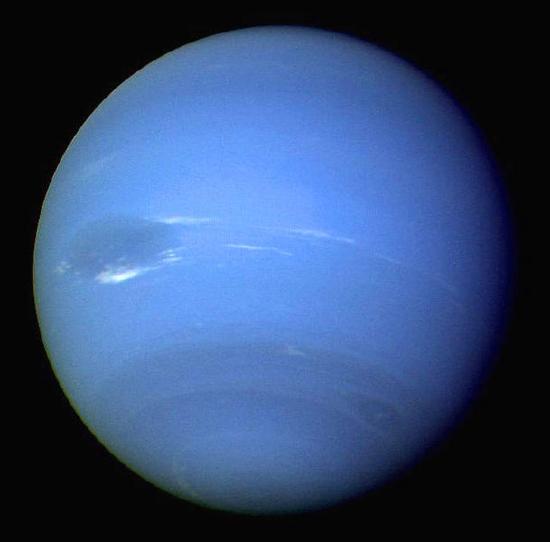Organic Compounds in The Solar System
- Page ID
- 50817
Every living thing on Earth is full of complex organic compounds, each essential to life. Generally, when thinking of organic compounds, looking past our own planet would seem to be a futile search. Visits to other planets by probes such as Voyager and Mariner have revealed either scorched, rocky orbs, or frigid globes of gasses. Given the primarily inorganic makeup of these planets, they would hardly seem to be places to house hydrocarbons or more complex molecules. However, even though the other planets do not show any sign of life, organic molecules are still present in surprising places, and exhibit properties and states not seen naturally on Earth.
One example is readily visible simply by looking at an image of the planets Uranus and Neptune. Their iconic blue color is caused by the presence of methane in the atmosphere[1], which absorbs infrared, red, and ultraviolet radiation. A diagram of methane is shown below.
Many different types of radiation of the electromagnetic spectrum also cause methane to undergo photolysis, producing trace amounts of other hydrocarbons. These include alkanes, particularly ethane, as well as various unsaturated hydrocarbons like acetylene (C2H2)[2].

The planets are not the only source of hydrocarbons in the solar system; asteroids and meteorites have acted as messengers from other worlds simply by crashing into Earth. Analyzing rocks from space might seem somewhat pointless at first; is there more to see than blackened rock comparable to any boulder on Earth? Suprisingly, scientists have found remnants of organic compounds, both basic and complex, in certain meteorites of the CI and CM classification[3]. The "C" in these acronyms stands for "carbonaceous", referring to not only the presence of elemental carbon, but carbon-containing compounds.
The most interesting of these compounds are amino acids, which are building blocks that comprise proteins, essential molecules for life. CI and CM meteorites contain an interesting variety of amino acids, including alanine and glycine, the two simplest some of the more prolific amino acids that polymerize to create proteins. While CI and CM meteorites share a number of similarities in organic constituents, in many ways they are drastically different in percentage composition of various amino acids, suggesting that there are multiple sources of organic compounds somewhere out there in the cosmos.
Other interstellar travelers, such as comets, have also been shown to contain organic compounds. Comet Wild 2, with which NASA's Stardust spacecraft made a rendezvous, returned aerogel samples containing methylamine and ethylamine. Both of these compounds are amines, important sources of nitrogen with a myriad of biological and industrial purposes. Scientists believe that comets, meteorites, and asteroids could have been crucial carriers of organic compounds to Earth when the planet was still in its infant stage. These extraterrestrial visitors may have made it easier for life here to begin.[4]

In the past, organic compounds were classified as those belonging to living organisms. However, the current definition includes all carbon-containing compounds, without being restricted to living systems. The simple presence of organic compounds does not imply that complex biological molecules, or even further, life, exists. Still, the great diversity of organic molecules drifting around in space is a phenomena to be examined. Where these substances originated, and how they were distributed throughout locations so different from Earth, may provide clues about the formation of our solar system, galaxy, and even our own planet.
From ChemPRIME: 8.0: Prelude to Organic Compounds
References
- ↑ wapi.isu.edu/Geo_Pgt/Mod14_Neptune/mod14.htm
- ↑ http://www.agu.org/journals/je/v105/iE08/1999JE001221/
- ↑ http://www.pnas.org/content/98/5/2138.full.pdf+html
- ↑ http://www.nasa.gov/centers/goddard/news/topstory/2006/stardust_result.html
Contributors and Attributions
Ed Vitz (Kutztown University), John W. Moore (UW-Madison), Justin Shorb (Hope College), Xavier Prat-Resina (University of Minnesota Rochester), Tim Wendorff, and Adam Hahn.


